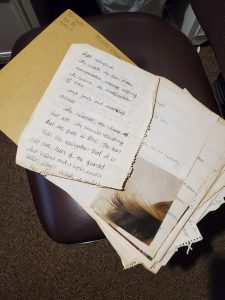In 1971, I majored in music theory and minored in piano at a little known college with a decent ranking music department in Brevard, North Carolina.
My most memorable class assignment was to write an essay about the one piece of work I would share with a friend to try to hook them into loving classical music.
The assignment was to choose the piece, write about the composer, and explain how it hooked me in.
I chose American composer Samuel Barber’s Adagio for Strings.
I never found the original essay, but I recently found a practice sketchbook full of poems and random thoughts, including a couple of pages about Barber and his magnificent work.
The notebook was a real find, and reading through the part about Adagio for Strings hit my own heartstrings and prompted me to bolt to the computer and write this blog post.
Samuel Barber was a pianist and just twenty-six years old when he wrote the approximately eight-minute second movement to his String Quartet in B minor, Op. 11 — Quatuor Diotima.
His inspiration was Virgil’s Georgics, a didactic poem divided into four sections.
This is the passage from Georgic III that was supposed to have inspired Barber:
As in mid ocean when a wave far off
Begins to whiten, mustering from the main
Its rounded breast, and, onward rolled to land
Falls with prodigious roar among the rocks,
Huge as a very mountain: but the depths
Upseethe in swirling eddies, and disgorge
The murky sand-lees from their sunken bed.
I can almost envision Barber’s epiphanic reaction to Virgil’s genius, and how he might recreate its awe-inspiring impact through a sorrowful musical quartet of strings.
Reading The Georgics out loud in English today, while simultaneously listening to Adagio for Strings, I rediscovered myriad layers of beautiful, melodic, heartbreaking, and inspiring verses.
Barber wrote the movement while living in Austria in 1936, as the world watched while Adolf Hitler violated the Treaty of Versailles and marched 22,000 troops into the Rhineland, just east of Germany’s border with France, Luxembourg, Belgium, and the Netherlands.
Adagio of Strings didn’t have its debut until November of 1938 when America was still reeling from the Great Depression, Europe was sliding into the chaos of war, and the Nazis were terrorizing the German Jews.
Now, I don’t know if I’m describing the musicality of Adagio correctly, but for me, it quietly starts with the stirring simplicity of a single note played by the violins. It mournfully sits alone for two long beats, followed by the viola and the cello.
The movement gathers momentum in a sequential cathartic pattern of notes.
The piece triumphantly reaches its heartbreaking prodigious roar of a climax at just over six minutes, and you think it’s over.
It’s so moving; you almost need it to be over.
But it’s not.
While you take in the climatic enormity of what you’ve just heard, the deafening moment of silence is interrupted by a chilling second entrance. From the pent-up depths, the movement comes churning up from the sunken bed and then softly fades away.
Ebb and flow. Ebb and flow.
The coming and going. Or is it the decline and regrowth?
Music aficionado Sally White of Westport, Connecticut, turned me on to Adagio for Strings back in the late ’60s. The first time I heard it, Sally literally held me up from crumbling into a heap.
Adagio of Strings was an enormous comfort to me in tough times, and I long ago decided that it would be the last act at my funeral. If this masterpiece is not played at my funeral, I’m not going!
My college essay notes were just a bunch of words and dangling modifiers, but reading them today, forty-eight years later, I sadly know exactly what I felt and meant to say.
The nuance
quiet
powerless but powerful
every quiet changing chord
changes
the reminder
of me
the slight rallentando
the teardrops falling
watching them
drip drop
sadness, loneliness
hopeless
manipulated
robbed
the rubato, the manipulation, the robbing
transparent
I can’t hide
no one can hide
the moving intimacy
the heartbreaking immediacy
the poignancy
emotional urgency
heartbreaking strings
heartstrings
moving quartet
That melancholy entrance
the heartbreaking climax. At the very end, two chords
Two seconds, maybe three,
Seems forever
The end
The string family
tragic
The violin, the baby
the viola, the older sister,
and the cello,
the cello.
Barber suffered from depression and alcoholism and died of cancer in 1981, at the age of 70.
Fast forward to 2005, when Dutch DJ and producer Tiësto turned Adagio of Strings into a dance extravaganza.
When I first heard it, I was beyond skeptical.
Tiësto started his repertoire with a thud thud thud.
I thought that the heavy pounding was no way to honor Barber’s classical movement.
And then Tiësto brilliantly stopped and paused for a second before throwing in the original Adagio angst.
I weirdly yelled out, YESSSSS loudly.
Then he shouted, “Make some noise,” and broke into a fist-pumping feel-good anthem that was invigorating and filled me with hope and recovery.
Tiësto took Adagio of Strings from its original heartbreak and conquest to liberation and salvation.
Make some freakin’ noise.
Like BAM—try as you might, nothing is going to take me down.
Ever.
The full String Quartet in B minor, Op. 11 (Quatuor Diotima) by Samuel Barber.
